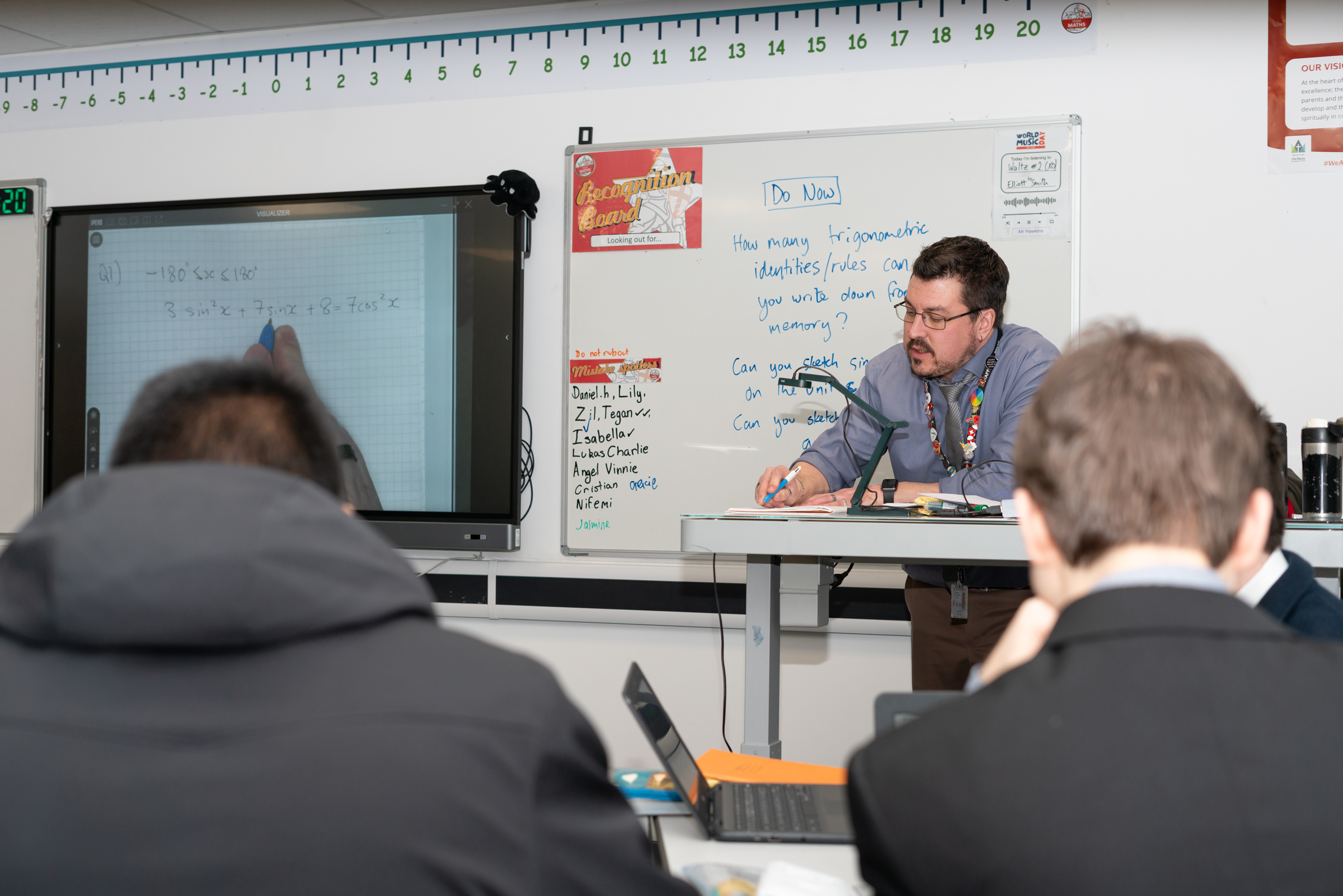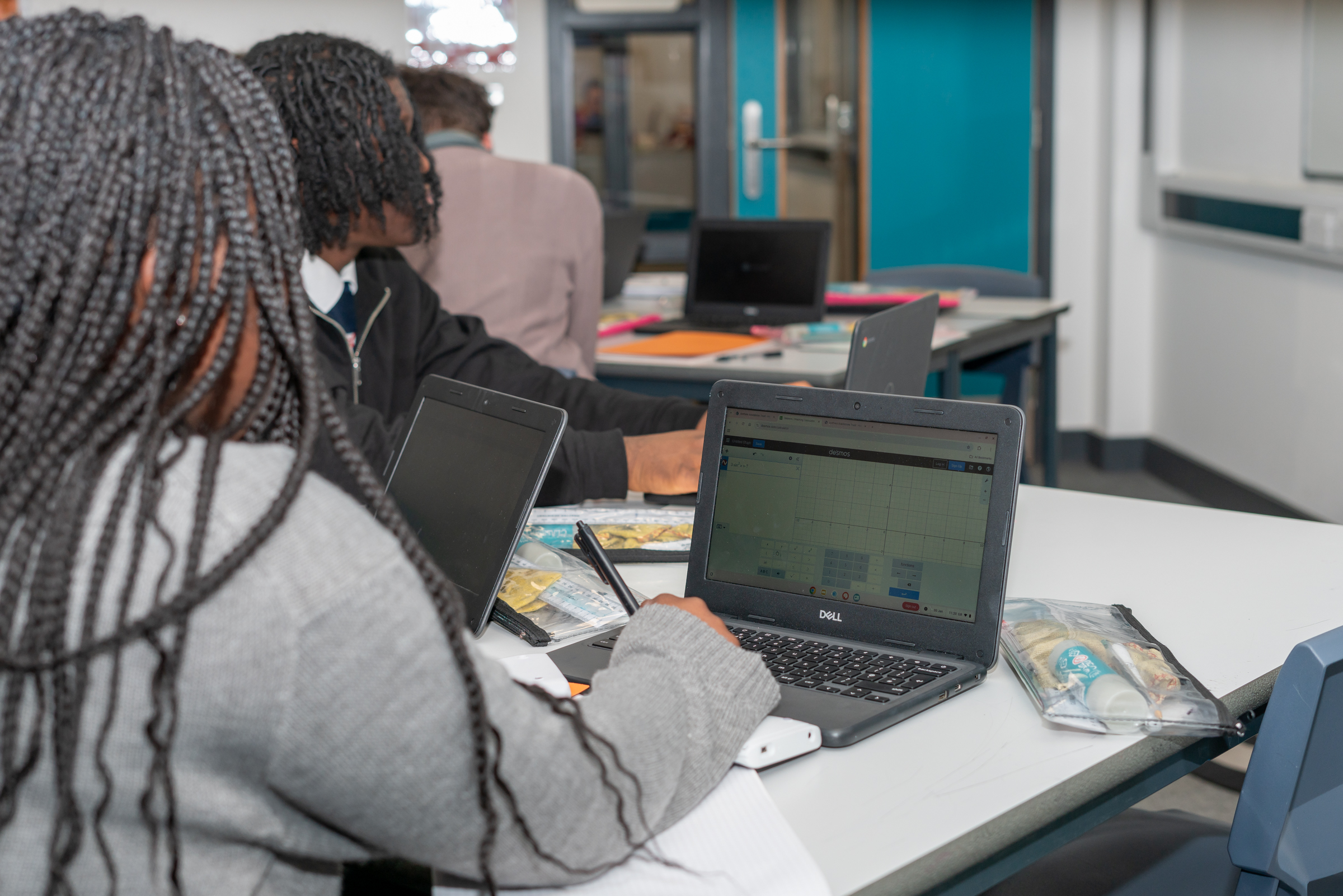Mathematics
Curriculum Leader: Mr E Hargreaves hargreavese@saintgeorgescofe.kent.sch.uk
The content for A level Mathematics is 100% prescribed covering Pure Mathematics, Statistics and Mechanics. There is no Decision Mathematics in this specification. There are overarching themes of mathematical argument, language and proof, problem-solving and mathematical modelling. There is an emphasis on the use of technology in the classroom.
Subject Requirements
- GCSE Maths - Grade 6 or above
Intent
Mathematics continues to be the most popular A level in the country due to the amazing benefits conferred on students by the qualification. At Saint George’s we want to help pupils to see maths as a deeply interconnected discipline and will look to draw links between topics at every opportunity, and by using technology in the classroom we build links between the algebraic and graphical representation of concepts in order to build a rich understanding of all content. A Level mathematics has a huge focus on being able to model real-world scenarios using mathematical techniques, and so we look to build a solid foundation of understanding so that students are able to apply their knowledge to novel contexts. We acknowledge that the study of A Level mathematics is no simple task and that our pupils will need to show incredible resilience if they are to be successful in their studies, but we promise to stand by and support our students every step of the way along their journey.

Implementation

At Saint George’s, we have a uniquely gifted team of specialist maths teachers who work tirelessly with our students to strive for the best outcomes. We use a mixture of approaches in the classroom to develop conceptual understanding and procedural fluency in tandem, as we believe each supports the other. Teaching is delivered through a variety of media involving the use of technology, particularly Microsoft Excel and graphing software such as Desmos. Throughout, students are encouraged to work collaboratively in groups to enhance their learning experience. Students are assessed regularly with at least one formal assessment in each of pure and applied each half-term, these results are then used by teachers to diagnose gaps in knowledge and highlight areas where further support may be required.
We ensure that SEND and disadvantaged children are given the necessary support in class to fully access the Curriculum and that equal opportunities are given to all.
Impact
The vast majority of our students leave Saint George’s with excellent outcomes compared to national averages and a love of the subject which we hope will stay with them for a long time. Having completed one of the most challenging A level courses they are excellently positioned to succeed in their next steps. We have had students going on to achieve entry into some of the most competitive university courses in the country, as well as apprenticeships and other forms of further education.

Topics
The content for A Level mathematics is 100% prescribed, with the main content being split between two-thirds Pure Mathematics and one-third Applied. Applied mathematics covers statistics and mechanics.
Pure mathematics is split into the following 10 topics over the two years:
- Proof
- Algebra and Functions
- Coordinate Geometry
- Sequences and series
- Trigonometry
- Exponentials and Logarithms
- Differentiation
- Integration
- Numerical Methods
- Vectors
Statistics:
- Sampling
- Data presentation and interpretation
- Probability
- Statistical distributions
- Hypothesis testing
Mechanics:
- Quantities and units in mechanics
- Kinematics
- Forces and Newton’s Laws
- Moments
Assessments
All units are equal weighting. 100% exam
| Unit Content | Unit Assessment |
|---|---|
|
AS Unit 1: Core Maths 1 - This extends your GCSE knowledge of Algebra, indices and coordinate systems. It also teaches you how to express your Mathematics correctly. This is the only non-calculator option. |
Module examination in May/June of Year 12. |
|
AS Unit 2: Core Maths 2 - This builds upon the work you did in Core 1. In this module, you begin to look at such topics as Calculus and Trigonometry. |
Module examination in May/June of Year 12. |
|
AS Unit 3: Statistics 1 - This module covers how to analyse data, the binomial distribution, probability theory and how to test whether a particular result is significant. |
Module examination in June of Year 12. |
|
A2 Unit 4: Core Maths 3 - This module extends the calculus techniques that you learnt in Core 2. It also looks at functions and natural logarithms. You will be required to produce a piece of coursework. |
Module examination in June of Year 13. |
|
A2 Unit 5: Core Maths 4 - This module is called Applications of Advanced Mathematics. The module extends all the topics you have learnt thus far and asks you to apply them in more complex situations. |
Module examination in June of Year 13 |
|
AS Unit 3: Mechanics 1 - This looks at how to model situations involving velocity, distance and time. It also considers the motion of projectiles. |
Module examination in June of Year 13. |
Examining board link: Edexcel A Level Mathematics
Mathematics Future Paths
Mathematics is a highly employable A-level to have. Most students who study Mathematics go on to careers in Engineering, Computer Science, Finance, Investment Analyst, Science and Research, Medicine, Economics, Statistician, Chartered Accountant, Systems Developer, Engineering, Accountancy and Finance, Cybersecurity, Education, Actuarial Science, Stockbroking, Statistician and Meteorology.
Extra Resources
- Video Tutorials - This is a useful website containing videos on all A-level topics which are a useful starting point for students who are reading ahead.
- YouTube: SnapRevise
- Advanced Mathematics Support Programme
- Maths Tutor
- Dr Frost Maths
- Khan Academy
Revision Materials
- Past question papers are an essential part of the revision process for Mathematics, it is important to get plenty of practice with the type of questions you will be asked in exams. At the end of each chapter in the textbook, there is a mixed exercise made up of past exam questions, and we always leave plenty of time after completing the learning for the module to do past paper practice, both under exam conditions and as an open book revision tool.
- Edexcel Past Papers
- Edexcel AS and A Level Modular Mathematics: Core Mathematics 1 By Keith Pledger and Mr Dave Wilkins (2008).
- Edexcel AS and A Level Modular Mathematics: Core Mathematics 2 By Keith Pledger and Mr Dave Wilkins (2008).
- Edexcel AS and A Level Modular Mathematics: Core Mathematics 3 By Keith Pledger and Mr Dave Wilkins (2008).
- Edexcel AS and A Level Modular Mathematics: Core Mathematics 4 By Keith Pledger and Mr Dave Wilkins (2008).
- Edexcel AS and A Level Modular Mathematics: Statistics 1 By Keith Pledger et al (2008).
- Edexcel AS and A Level Modular Mathematics: Mechanics 1 By Ms Susan Hooker et al (2008).
